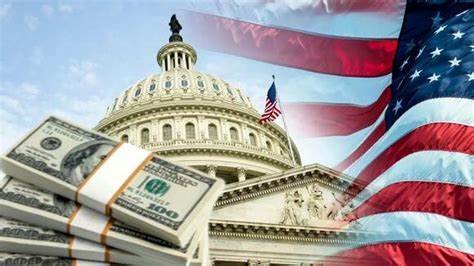The U.S. is losing its global economic advantage due to inconsistent policies. Economists at the U.S. central bank now think a full economic crisis is just as likely as slow growth this year. The S&P 500 trades at 22.4x forward earnings – a level usually seen during mid-cycle expansion. Yet the U.S. economy shrank in the first quarter, the first time in two years. This odd mismatch shows cracks in America’s economic foundation.
Global markets already feel the effects of these mixed signals. The yield on ten-year Treasuries shot up by 50 basis points to 4.6% in just a month. This shows waning trust in U.S. economic leadership. Earnings forecasts for 2025 dropped by a lot from 14.5% to 9.2%. The International Monetary Fund also cut its global growth outlook for 2025 from over 3% to 2.8%, blaming increased trade tensions.
This economic shakiness isn’t just a short-term problem. The federal deficit spending looks to hit $1.9 trillion in 2024-25 – the third-highest in American history. Annual deficits already top 6% of GDP, and the impact reaches way beyond U.S. borders. Investors now turn to other wealth stores like gold, while recent Treasury auctions attract fewer buyers than expected.
The rise of policy inconsistency in U.S. economic strategy
Policy inconsistency marks recent U.S. economic governance and creates waves throughout global markets. America’s traditional role as a stabilizing force in the world economy has weakened due to this back-and-forth approach to economic management.
Executive orders and short-termism
Executive orders have accelerated policy volatility in the American economic world. The administration launched what experts call “the worst White House assault in history on the environment and public health, an all-of-government assault with potentially devastating results” during the first few weeks of 2025. Their approach brought immediate confusion after they arbitrarily froze trillions of dollars in federal spending. The freeze was rescinded the next day following court intervention. Executive orders have targeted everything from trade policies to federal workforce cuts, with plans to eliminate about 75,000 government employees—roughly 3% of the total federal workforce.
Frequent reversals in trade and fiscal policy
Sudden policy changes have become common, especially with tariffs and international trade. One analyst noted, “Firms across the world have been trying to come to terms with the rapid rate of presidential kneejerks: where policies can be announced, adjusted and shelved as quickly as the leader of the free world can publish a social media post”. This pattern showed when potential tariff exemptions for childcare products were first dismissed as “peanuts.” Yet within days, the treasury secretary told Congress these exemptions were “under review”. Economists call this inconsistency an “uncertainty tax”—a hidden but powerful drag on economic performance that reduces growth by delaying business investments and lowering consumer confidence.
Effect on institutional credibility
American’s confidence in their government has dropped to just 41%. This trust erosion directly affects how economic policies work. Research reveals that states with higher institutional trust respond better to monetary policy changes. Models predict that the macroeconomic response to identical monetary policy surprises will be 20% milder in 2025 compared to 1990 due to falling trust. Moody’s recent downgrade of U.S. sovereign debt from AAA to Aa1 highlights these structural fiscal challenges. This policy inconsistency continues to weaken America’s economic credibility globally.
How erratic U.S. policy is reshaping global markets

Image Source: LSEG
America’s erratic policy decisions are sending shockwaves through global financial markets. These decisions have changed the basic economic relationships that remained stable for decades.
Currency volatility and weakening USD
The U.S. dollar’s weakness against major currencies has created unprecedented market volatility. The dollar index has dropped more than 9% this year, hitting its lowest point in three years. Bank of America’s Global Fund Manager Survey shows that 61% of participants expect the dollar to fall further over the next 12 months. This marks the bleakest outlook from major investors in almost 20 years.
The dollar’s decline goes against typical market behavior during uncertain times. Investors usually prefer dollar-based assets when markets are unstable. Safe haven currencies have grown stronger. The Japanese yen has gained over 10% against the dollar. The Swiss franc and euro have risen about 11%. Analysts call this pattern a “Dollar Frown” – the USD loses value during both economic downturns and upswings.
Bond market instability and rising yields
Treasury yields have shot up sharply despite weak economic signals, creating chaos in bond markets. The ten-year Treasury yield jumped 50 basis points to 4.6% in less than a month. The 30-year Treasury rate briefly went above 5%. The April 2 tariff announcement sparked more volatility. The 10-year yield jumped from under 4% to 4.5% in just four trading days.
The real 5-year-5-year forward yield stands at its highest level since 2010. This suggests investors want higher risk premiums on U.S. government debt. Moody’s recent downgrade highlighted the need for better fiscal management. Treasury securities’ role as the world’s safest asset faces serious questions now.
Investor shift to gold and crypto
Investors are moving toward different ways to store value as trust in traditional U.S. assets drops. Gold has become more popular, while cryptocurrency investments have exploded. Bitcoin ETFs have pulled in more than AED 33.05 billion in just over a month.
International investment patterns have changed dramatically. Foreign investors used to put about AED 25.70 billion weekly into U.S. stocks. These investments have now stopped completely in recent months. European stocks have caught investors’ attention instead. The money flowing into European markets matches the highest levels seen in the past two years.
The ripple effects on global trade and cooperation
Image Source: Dreamstime.com
U.S. trade policy uncertainty has created waves of change in global commerce that reach way beyond America’s borders.
Disruption of global supply chains
Substantial tariffs have completely changed how global supply chains work. The U.S. rolled out trade measures in April 2025 that threatened vulnerable economies with devastating impact. Tariffs ranged from 11% for Cameroon to 50% for Lesotho. A 90-day pause helped temporarily, but businesses have already felt the impact. Companies now:
- Route their imports directly into Canada
- Target Latin and South American markets more heavily
- Utilize technology to redirect shipments
Semiconductors, batteries, electric vehicles, and AI-related technologies have seen the biggest impact, with major reshoring investments. Swiss Re reports that supply chain disruptions now cost businesses AED 675.64 billion each year.
Erosion of multilateral trade systems
The international trade system faces challenges never seen before. WTO Trade Monitoring Report shows members implemented 137 new trade-restrictive measures between October 2017 and October 2018. This trend threatens decades of tariff reductions and peaceful trade dispute resolution.
Developing economies would suffer the most without the multilateral system. Global trade in goods would drop 33% and permanent GDP loss would exceed 5%. The least developed economies could see their exports plummet by 43%. The WTO Secretariat must now calculate what happens if countries fail to work together on these issues.
Emerging markets and capital flow shifts
Money flows have taken a dramatic turn. Investors pulled their money from U.S. equities and moved it to European and emerging markets due to U.S. fiscal policy and trade tariff concerns. U.S. equity funds lost AED 90.70 billion in May 2025, while European funds gained AED 77.11 billion.
Emerging market equity ETFs gained AED 13.22 billion last month, pushing total gains to AED 40.76 billion this year. Countries like Mexico, Thailand, and Malaysia remain vulnerable to these policy changes. Mexico’s exposure is particularly high with U.S. exports making up 27% of its GDP. These conditions push emerging markets toward regional integration and stronger economic ties with China.
Corporate and consumer fallout from economic unpredictability
Image Source: IoT Analytics
Economic whiplash from inconsistent policies hits American businesses and households hard in their daily financial decisions.
Delayed investments and hiring freezes
Companies now hesitate to make major business decisions due to growing economic uncertainty. Recent data shows that 20% of companies have stopped hiring, while about 5,700 companies announced job cuts and hiring freezes in 2024. This caution goes beyond just staffing decisions. Companies wait for clear policy direction before making capital expenditures and investment choices. Tax reforms should have encouraged business investment, yet companies hold back. They choose to watch and wait instead of risking their resources in this unpredictable climate.
Rising costs for businesses and households
Policy inconsistency makes its mark on prices more clearly now. Companies will raise their prices to cover tariff costs – 54% of them say so. The numbers paint a stark picture: 77% of service firms and 75% of manufacturers already push these costs to their customers. The situation looks worse when you consider that 30% of manufacturers and about 45% of service providers pass all higher costs straight to consumers. These price changes happen faster than expected – 35% of manufacturers bump up prices within a week of facing tariff-related cost increases.
Inflationary pressure and reduced purchasing power
Americans watch their money buy less as prices climb faster than their paychecks – the real cost of inflation. This creates ripple effects throughout the economy:
- Future homebuyers and people with lower incomes feel the squeeze more than others
- Small companies with thin profit margins that depend on loans face bigger hurdles
- Medical expenses outpace general inflation, adding extra strain
Families put off big purchases more often. Many cancel their vacation plans and cut back on optional spending. People in Oakland and Chicago say their “anxiety through the roof” as they deal with 10% increases in wholesale prices and worry about losing their jobs. When people spend less, businesses suffer, which makes the whole economy more unstable.
The Long-term Consequences of America’s Economic Uncertainty
America faces a defining moment. Our analysis reveals a grim reality of an economic superpower stumbling because of unpredictable policy decisions. Without doubt, these effects reach way beyond the reach and influence of U.S. borders. They reshape global markets and threaten economic relationships that are decades old.
Financial markets react to these inconsistencies. A weaker dollar, climbing Treasury yields, and investors rushing to alternatives like gold show declining faith in America’s economic leadership. Businesses put off vital investments. Consumers struggle with rising inflation. This creates a cycle that keeps eating away at economic stability.
The damage to institutional credibility raises even more red flags. People’s trust in economic governance has plummeted. This makes monetary policy less effective right when strong leadership matters most. This loss of faith becomes especially dangerous with federal deficit projections and upcoming fiscal challenges looking worse by the day.
Global trade faces major rebuilding. Supply chains move away from U.S. dependence. Countries work less together, and emerging markets look for new allies. These changes might seem slow, but together they threaten America’s key role in the global economy.
Moving forward depends on keeping policies consistent. Economic players—from big corporations to regular households—need reliable guidelines to make sound decisions. Markets will keep looking for alternatives to U.S.-centered systems until stability returns.
Everything hangs in the balance. America’s economic power has kept the world stable for generations. The country might lose its economic leadership position if policy inconsistencies don’t get fixed quickly. Such a fundamental change would reshape the world order for decades.



